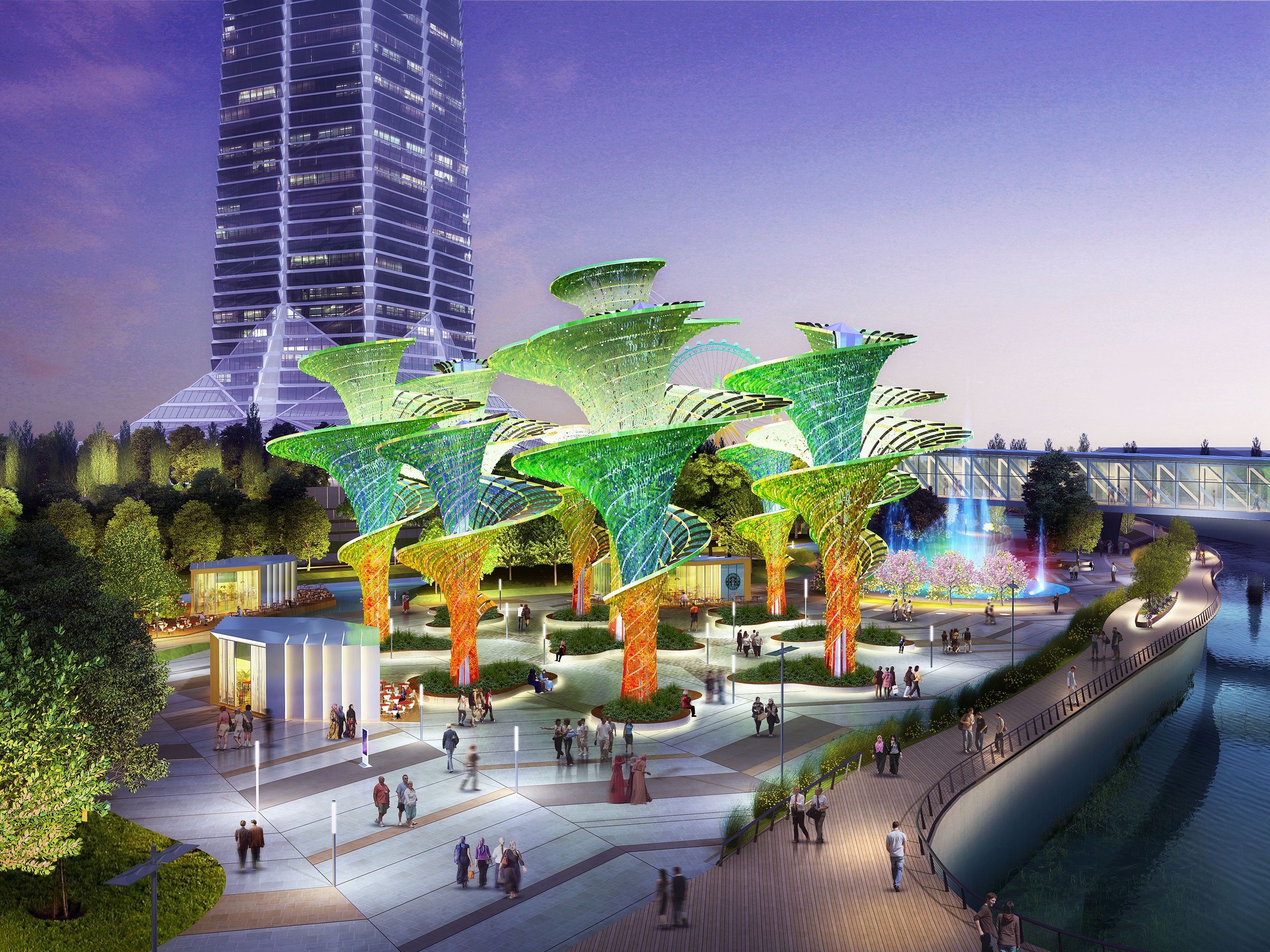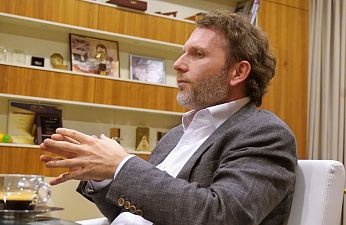Ram, many architects are saying that modern buildings are lacking beautiful details that could catch the eye. Do you agree?
- It depends on the eye. An architect and a layman often see beauty differently. Details can be different too. A cube, for example, can be hideous or absolutely beautiful, depending on execution. Let’s talk about Zaryadye Park. I was there yesterday. The idea is very interesting, but from an architect’s point of view, many details are disappointing. Beautiful and expensive materials were used, but the quality of construction is poor in many areas. Obviously, this location calls for high quality work.
What percentage of Chapman Taylor’s portfolio is made up of retail real estate projects?
- This number is constantly changing. In the 1980s, our company was mostly designing residential buildings in England. However, after the crisis of 1990s, we started working in other countries. Currently, we have 19 studios all over the world, which mostly design commercial real estate, produce major master-plans, and build multifunctional facilities that always include a trade gallery, being a focal point of a project. I believe, contracts for retail centers or with a retail component currently make up half of our portfolio.
If railroad stations and airports are the face of a city, what would the shopping centers be?
- To answer this question, we have to go back and remind ourselves of how the concept of a shopping center initially evolved. It was developed in the last century, in America. Historically, there were never trading streets in America, which developed naturally in Europe since the Middle Ages. America studied the European experience and created its own design that was based on trade streets under one roof, with a comfortable climate maintained inside a building.

Thus, a new type of structure was invented. A large shopping center, which also offered various services. Later, the concept of a shopping center returned back to Europe, initially in the form of smaller shopping centers and, later, аs large multistory shopping malls. The idea has not changed. Historically, a trading place was the central place in a city and it attracted everyone. It makes city life livelier. A successful shopping center is the heart of a neighborhood.
In the United Kingdom, large shopping centers are currently built outside the cities, not in the cities
- This is the current government policy. People usually drive to shopping centers, and authorities are against increasing traffic in city centers where traffic is heavy already. In addition, cars have a negative impact on the environment. Thus, shopping centers are built in the suburbs. It has become known that these projects interfere with normal life of the cities. People and families go to shopping malls and spend entire weekends there. Cities become deserted and authorities want cities to stay vibrant, they want people to work, live, and spend their leisure time in one area, as well as walk more. That is why suburban malls are being controlled.
Currently, there is a new architectural trend in the United Kingdom. It has become popular to build multifunctional facilities that combine different functions in one area and, sometimes, under one roof. For example, a center designed for the summer Olympic Games in England that includes a railroad station, a shopping mall, a sports facility, hotels, offices, and new streets with restaurants. Different functions are complementing each other, which helps the whole project to be successful.
What аre the current requirements for design service life for retail and leisure centers?
- Everyone is looking for the everlasting success. Of course, it is not possible. A high quality facility will survive longer. On average, certain maintenance is required every ten years, since it is a live organism and minor things are changing there every day. These are either new tenants, new elements, or seasonal changes. It is natural evolution and wear and tear.
Speaking about new shopping centers, what design changes have been introduced in the last ten years?
- Developers are paying more attention to the quality of architectural design. In the past, people were building boxes with stores inside. Now, many developers are trying to create centers that have attractive architectural design. Why? The market is changing and there is competition between the malls. They have to attract customers and demonstrate long-term success. Simple marketing, good logistics, and planning are not sufficient for success anymore. It is necessary to have an architectural concept and a comfortable environment for the customers.
And customers demand higher standards…
- Yes. Customers are not interested in simple shopping anymore, they are looking for experiences. Architecture, landscape, and environment can provide the desired experience. Of course, it is not the primary goal of this business, but it is a very important part of it. That is why major developers, regardless of the difficult times, are trying to be on the forefront and be leaders in this area. As a result, strong companies become even more successful. The rest are becoming outsiders and disappear.
Should designers of the retail centers take surrounding architectural style into account?
- While designing any building, it is necessary to take the surrounding environment into account. It includes retail centers. For instance, our project in Bath, where we could only use local sandstone for construction. In addition, the city had very strict architectural requirements. Nevertheless, we built a large retail center that fits in perfectly into the surrounding environment. Galeria shopping and entertainment center in Saint Petersburg is another excellent example. Together with our customer and the city government, we invested a lot of time and energy into integrating it into the surrounding environment. A lot was invested in creating the facades! It is much easier to work in historic cities such as Saint Petersburg or old European cities where construction projects have to follow specific requirements. In many Russian cities of the Soviet period, the surrounding environment, including buildings, the site, and transportation are usually of poor quality. In these cases, we have to design facilities that would become a reference point for future development in the area.
Do you take national peculiarities into account when designing a project?
- Absolutely! A shopping center should be, first of all, understood and accepted by the customers. Although, sometimes contrast and novelty work well too. That is why we also build “extraterrestrial” malls. People could love an alien, just like they love one of their own. Otherwise, it will not be successful.
It seems to me, that more centers with unusual architecture are built in China than anywhere else . Why?
- Firstly, they build many new cities where new architectural styles are appropriate. Secondly, a big country like China can easily accept a multitude of trends, styles, and scale. Context is not always a defining factor. Thirdly, each nation has a distinct taste. Just look at Chinese commercial streets. As a rule, they are livelier and more colorful than European. They look like a multinational carnival and sound like an endless buzz. Thus, malls can be unusual, colorful, etc.
Which of the retail and leisure centers that you designed are your favorite?
- Usually, we look at the results with the eyes of our customers. We like projects that become successful. The latest successful example is Mega Silkway shopping center in Astana, which was opened last year. A reserved, dynamic, and slightly extraterrestrial. It was definitely a cool project, which became a part of the new Expo Center and its gate. Mega Silkway is very spacious with plenty of air. It is not a secret that customers experience stress while shopping, especially men. In this center, we were able to create a modern environment that is comfortable at any time and, I hope, customers experience minimal level of stress. Both our client and the local population gave us rave reviews, but it was not an easy task.
You are designing Grozny Mall in Chechnya. Is it a challenging project?
- It is special. Located in the central part of the city that has a large park, and the park will become a part of the mall. Architectural design of the center includes an octagon, an Islamic symbol. It is presented in an abstract way, not obvious. This mall has not four facades, but five. The roof is facade number five. The roof design required special attention since the mall can be seen from a nearby tower, 300 meters high. It was not an easy task. The customer had very clear view about this project and provided very specific requirements to us. It is also important that Chechnya has its history, its own culture and traditions, which provide context. We must study its architectural examples in order to do everything right.

Have you traveled to Grozny yourself?
- Yes. Everyone was surprised where I was going, but I enjoyed it. We did not have any issues communicating, we spoke Russian. I was pleasantly surprised to see that a city that was recently affected by war was able to heal its wounds.
Do you have many major contracts in Russia?
- We have been designing the Dream Island, an entertainment park in the center of Moscow for Regiony Group. It is probably the most unique and large-scale project in our current portfolio. Currently, Russian market is going though a very complex crisis, instability, and sanctions. There are many changes in the political situation, many legislative changes, practically no foreign investment, which slows down the development. At the Russian office, we work with projects in other countries, not only in Russia. For example, in partnership with our London office we are currently remodeling the Dubai Mall. They have many movie theaters, but our customer wants to have more. We also have large projects in Uzbekistan.
What is more important at the modern shopping centers, individuality or functionality?
- Everything is important. On the one hand, a shopping center has to be an absolutely efficient machine. On the other, just like humans, it needs to have personality. We win if we are able to achieve both.
The notion of a shopping center has changed significantly in recent years. What is appropriate to have at a shopping center? Would a museum be ok?
- Theoretically, yes. However, shopping malls are created by private developers, and a museum, or, let’s say, a library would be a social project that won’t generate profit. As you know, even movie theaters pay lower rent than stores because they are not as profitable. Movie theaters are included in the design anyway because they attract people. The same can be said about other functions. Sometimes it would be appropriate and sometimes not. There is a general rule: we have to make people happy; we have to provide all types of conveniences; we need a wow! effect. Therefore, we try to add elements to shopping centers that people do not see in their everyday life. For example, European shopping centers used to be decorated with palm trees. In Qatar, at the shopping center designed by our Spain bureau, there are many plants, fountains, and pools. Now there is a cool oasis in a desert. All this helps centers to be more profitable.
What else can increase competitive ability of a new retail center?
- Efficient and sound layout. It is the most important part. Layout is the core, which allows a retail center to move forward. 90% of the architect’s time and effort is spent designing the layout of a shopping center. Everything else is complimentary.
After the tragedy in Kemerovo, the chief architect of Moscow, Sergey Kuznetsov, noted that “shopping malls are ugly, and bring benefits only to the owners and creating problems for the cities.” Do you agree with this statement?
- I understand Mr. Kuznetsov, if he said it. It seems to me that government must set general rules of the game, and designers and developers must comply with these rules. Architects are not revolutionaries, and it is not their role to decide what type of facilities cities need. As far as ugliness, a shopping center should not be ugly and an architect must help a developer to be sensitive to the context, but government too should help resolve issues.
It would be good, if government paid more attention to the beautiful landmarks of the past. No doubt, the restoration work is taking place, and it is welcome. But, for a long time, many landmarks were in a very bad shape. In the past, I used to be involved in historic preservation in the United Kingdom. I participated in such important projects as restoration of the London Opera House, Kensington Palace, buildings on the Trafalgar Square, and more. I was able to see that corresponding organizations and government agencies are able to achieve more, if certain conditions are created by the city. Heritage can be appropriately preserved. It will create the context for future construction projects as I mentioned it before.
If the context is lacking, government can also facilitate the creation of the context. One example would be the Canary Wharf Commercial Estate in London. It was erected in 1980s. There are many foreign architectural details because American architects were invited to work on this project. Government issued rules of development and strict conditions for this project, in order to achieve a quality result. Now, every building in this district has character, and they are definitely high quality. It would be nice if we could utilize this experience in Russia.
How do you see future shopping centers? What will be the next iteration of this concept?
- Market leads the change. Current trend is based on a multitude of elements at a shopping center. There should be stores, entertainment, and restaurants. It helps malls to be more efficient and makes the image of a “greedy box” a little softer. Next step would include multifunctional projects, just as in Europe, where market is more mature.
Ramchandra Khatiwada
Received his professional architectural degree at Westminster University in London, United Kingdom, and is registered with the Architects Registration Board of the United Kingdom. He is a RIBA licensed architect. In the beginning of 1990s, worked as an architect for Richard Sheldon, a London bureau; later chief architect at MRDA. Since 1999 to present time, has been working for Chapman Taylor. In 2007, opened and became head of Chapman Taylor studio in Moscow.

 Подписаться
Подписаться


